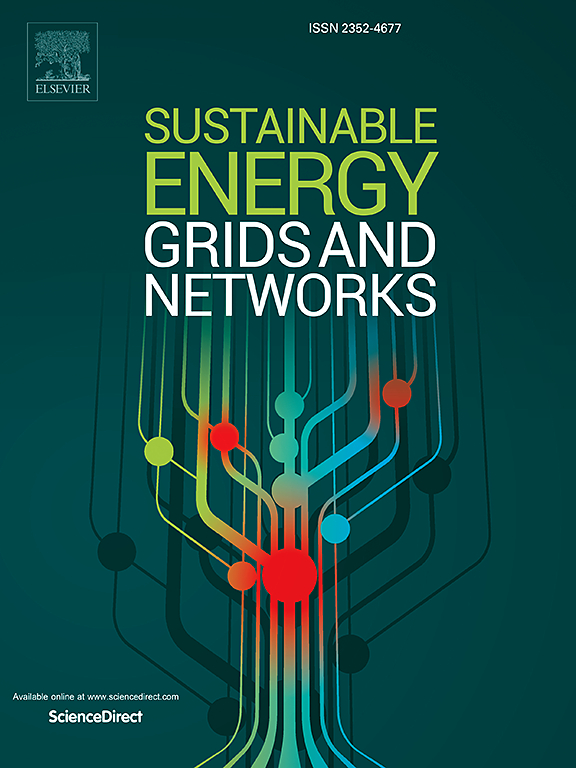临界事故感知的圆锥交流输电网络扩容与无功协同规划
IF 5.6
2区 工程技术
Q2 ENERGY & FUELS
引用次数: 0
摘要
经济和环境限制限制了新的输电线路安装,迫使运营商在考虑电压支持、交流潮流(ACPF)方程和N-1可靠性的同时,最大限度地利用现有基础设施,这大大增加了计算复杂性。本文提出了一种基于ACPF方程并结合N-1有功和无功可靠性准则的静态输电网扩容规划(TEP)计算效率高的模型和求解方法。为提高效率,在模型中引入无功规划(RPP)代理,通过协调无功电源部署,减少不必要的线路扩容。该问题被表述为一个混合整数二阶锥规划(MISOCP)模型,考虑了所有现有和候选传输线的偶然性。只有一小部分输电线路中断会导致违反运行约束。因此,确保关键突发事件的可靠性就足够了,因为考虑到所有这些都会增加复杂性。因此,提出了一种关键事件筛选方法,该方法通过依次求解主问题和子问题来识别关键案例。主问题类似于最初的MISOCP,但只包括偶然事件的子集,通过迭代逐渐扩展。子问题使用两级最大最小优化来筛选导致最严重操作约束违反的最严重偶然事件。这些最糟糕的偶然性被逐步添加到主问题中,确保最终子集准确地表示收敛时的全部偶然性。在Garver和IEEE 118-Bus测试系统上的数值结果表明,该方法在可接受的时间范围内有效地求解了所提出的TEP模型。本文章由计算机程序翻译,如有差异,请以英文原文为准。
Critical contingencies-aware conic AC transmission network expansion and reactive power co-planning
Economic and environmental constraints limit new transmission line installations, forcing operators to maximize existing infrastructure utilization while considering voltage support, AC power flow (ACPF) equations, and N-1 reliability, which significantly increase computational complexity. This paper presents a computationally efficient model and solution approach for static transmission network expansion planning (TEP) based on ACPF equations and incorporating the N-1 reliability criterion for active and reactive power supply. To improve efficiency, a reactive power planning (RPP) proxy is integrated into the model to reduce unnecessary line expansion by coordinating reactive power source deployment. The problem is formulated as a mixed integer second-order cone programming (MISOCP) model, factoring in contingencies across all existing and candidate transmission lines. Only a small subset of transmission line outages results in operational constraint violations. Therefore, ensuring reliability for critical contingencies suffices, as considering all increases complexity. Thus, a critical contingency screening approach is proposed in which critical cases are identified by sequentially solving a master problem and sub-problem. The master problem resembles the original MISOCP, but includes only a subset of contingencies, gradually expanded through iterations. The sub-problem uses bi-level Max-Min optimization to screen the worst contingencies causing the worst operational constraint violations. These worst contingencies are progressively added to the master problem, ensuring the final subset accurately represents the full set of contingencies upon convergence. Numerical results on Garver and IEEE 118-Bus test systems demonstrate the proposed approach’s efficiency in solving the proposed TEP model within the acceptable time frame.
求助全文
通过发布文献求助,成功后即可免费获取论文全文。
去求助
来源期刊

Sustainable Energy Grids & Networks
Energy-Energy Engineering and Power Technology
CiteScore
7.90
自引率
13.00%
发文量
206
审稿时长
49 days
期刊介绍:
Sustainable Energy, Grids and Networks (SEGAN)is an international peer-reviewed publication for theoretical and applied research dealing with energy, information grids and power networks, including smart grids from super to micro grid scales. SEGAN welcomes papers describing fundamental advances in mathematical, statistical or computational methods with application to power and energy systems, as well as papers on applications, computation and modeling in the areas of electrical and energy systems with coupled information and communication technologies.
 求助内容:
求助内容: 应助结果提醒方式:
应助结果提醒方式:


